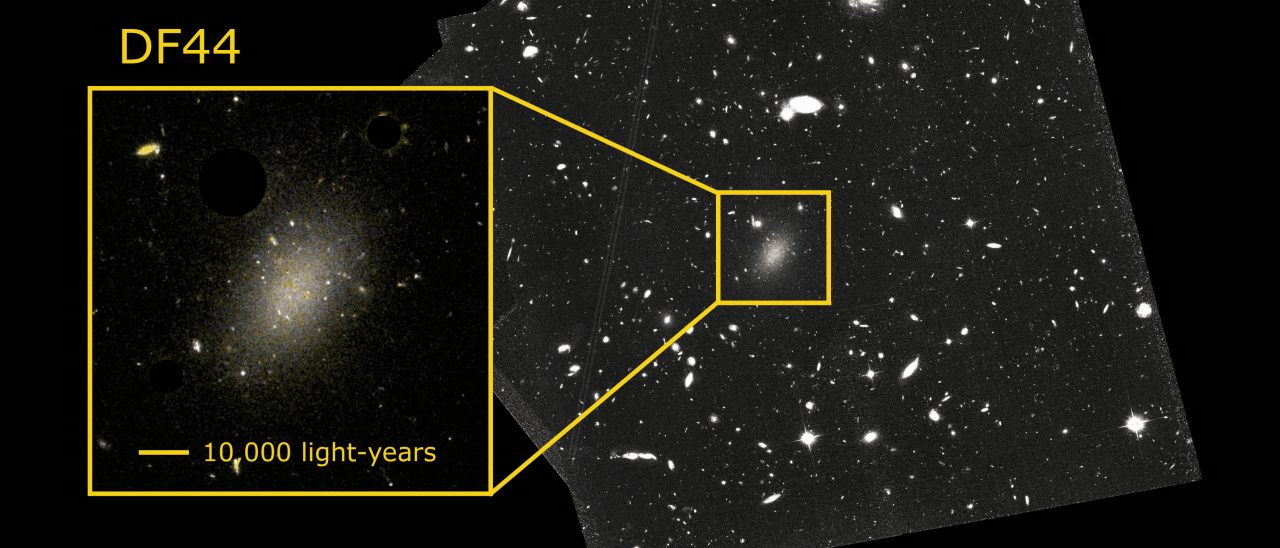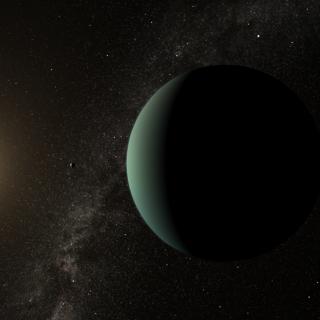At present, the formation of galaxies is difficult to understand without the presence of a ubiquitous, but mysterious component, termed dark matter. Astronomers have measure how much dark matter there is around galaxies, and have found that it varies between 10 and 300 times the quantity of visible matter. However, a few years ago, the discovery of a very diffuse object, named Dragonfly 44, changed this view. It was found that this galaxy has 10,000 times more dark matter than the stars. Taken back by this finding, astronomers have made efforts to see whether this object is really anomalous, or whether something went wrong in the analysis of the observations. Now we have the answer.
An international team led by the Kapteyn Institute of the University of Groningen (the Netherlands), with participation by the Instituto de Astrofísica de Canarias (IAC) and the University of La Laguna (ULL), has found that the total number of globular clusters around Dragonfly 44 and, therefore, the dark matter content, is much less than earlier findings had suggested, which shows that this galaxy is neither unique nor anomalous. The result was recently published in Monthly Notices of the Royal Astronomical Society (MNRAS).
The galaxy Dragonfly 44 was discovered in a deep survey of the Coma cluster, a cluster with several thousand galaxies. From the start, the galaxy was considered remarkable by the researchers because the quantity of dark matter they inferred was almost as much as that in the Milky Way, the equivalent of a billion solar masses.
However, instead of containing around a hundred thousand million stars, as has the Milky Way, DF44 has only a hundred million stars, a thousand times fewer. This means that the amount of dark matter was ten thousand times greater than that of its stars. If this had been true, it would have been a unique object, with almost 100 times as much dark matter as that expected from the number of its stars.
Nevertheless, by an exhaustive analysis of the system of globular cluster around Dragonfly 44, the researchers have detected that the total number of globular clusters is only 20, and that the total quantity of dark matter is around 300 times that of the luminous matter, which means that it is not way outside the normal value for this type of galaxies.
“The fact that in our work we found only 20 globular clusters, compared with the 80 previously claimed, reduces drastically the amount of dark matter which the galaxy is believed to contain”, explains Ignacio Trujillo, an IAC researcher and a co-author of the article. “Moreover, with the number of globular clusters we found, the amount of dark matter in Dragonfly 44 is in agreement with what is expected for this type of galaxies. The ratio of visible to dark matter is no longer 1 in 10,000 but one in 300”, adds Trujillo.
"Dragonfly 44 has been an anomaly all these years that could not be explained with the existing galaxy formation models. Now we know that the previous results were wrong and that DF44 is not extraordinary. It is time to move on", points out Teymoor Saifollahi, researcher at the Kapteyn Institute and the first author of the article.
“Our work shows that this galaxy is not so singular nor unexpected. That way the models of galaxy formation can explain it without the need for modification”, says Michael A. Beasley, another IAC researcher, specialist in globular clusters, and a co-author of the article.
The total number of globular clusters is related to the total mass of a galaxy. So, if the number of globular clusters is measured, the quantity of dark matter can be found, especially if the quantity of visible matter is only a small fraction of the total.
“However, we don’t have a physical explanation for this relation between the total number of globular clusters and the total mass of the galaxy. This is purely observational knowledge. It could be that it has to do with the quantity of the original gas from which the stars, and the globular clusters themselves, have formed. The more dark matter there is in a galaxy, the more gas it contains”, suggests Johan H. Knapen, an IAC researcher and also a co-author of the article.
Article: Teymoor Saifollahi, Ignacio Trujillo, Michael A. Beasley, Reynier F. Peletier y Johan H. Knapen. “The number of globular clusters around the iconic UDG DF44 is as expected for dwarf galaxies”. MNRAS, 2020: https://academic.oup.com/mnras/advance-article/doi/10.1093/mnras/staa30…
- Abstract: https://academic.oup.com/mnras/advance-article-abstract/doi/10.1093/mnr…
- Arxiv: https://arxiv.org/abs/2006.14630v4
Contact at the IAC:
- Ignacio Trujillo: itc [at] iac.es (itc[at]iac[dot]es)
- Michael Beasley: beasley [at] iac.es (beasley[at]iac[dot]es)
- Johan Knapen: jhk [at] iac.es (jhk[at]iac[dot]es)



